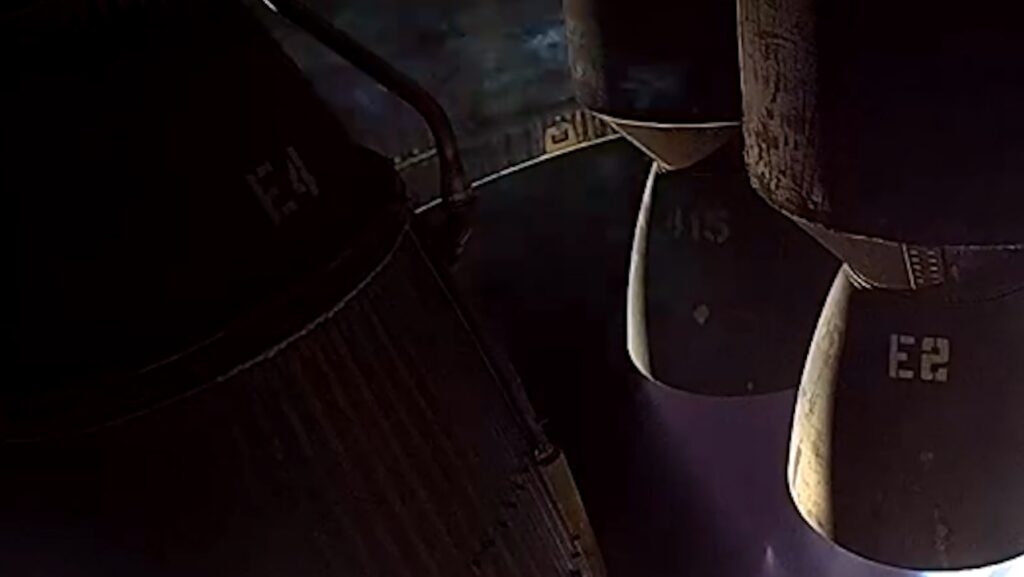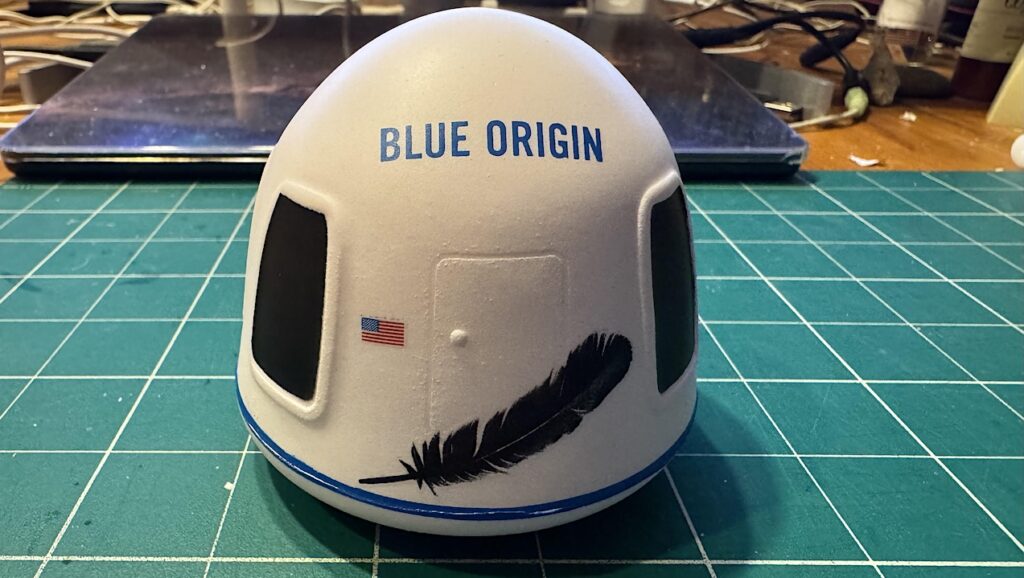Lockheed Martin's Bad Orion Marketing Hype
|
|
 Keith’s note: Bragging about things that a simple Google search can refute isn’t the best marketing approach, Lockheed Martin. Here’s a list of the past week’s desperate bragging attempts by Boeing and Lockheed Martin:
Keith’s note: Bragging about things that a simple Google search can refute isn’t the best marketing approach, Lockheed Martin. Here’s a list of the past week’s desperate bragging attempts by Boeing and Lockheed Martin:
– Denial At Boeing Regarding Poor Performance On SLS, earlier post
– You Can’t Exert National Prestige With A Rocket That Does Not Fly, earlier post
– Lockheed Martin’s Flawed Comparison Between Orion and Dragon, earlier post









While this isn’t a good look, I doubt many space news websites will point this out, let alone mass media news sites. So their assertion will go largely unchallenged.
Unfortunately, that’s not atypical for press releases. I’ve seen plenty press releases about “discoveries” by planetary missions which weren’t really new discoveries. Things like discoveries of water on Mars or a subsurface ocean Europa are frequent examples. Those are more like new measurements providing additional evidence of something “suggested by” or “found” or “discovered” by past observations. I even know one scientist who got an email from a high school teacher he’d taken classes from decades ago, telling him planetary scientists need to remember that things can only be “discovered” once. And water on or in Mars or Europa is only the tip of the iceberg.
Even when it comes to technology, there are lots of dubious claims in press releases. The Parker Solar Probe is supposed to have the most advanced, on-spacecraft autonomy ever. But when I compare what the press releases say those capabilities are, they don’t sound so new and different from some other robotic spacecraft I’m familiar with. It’s more like the capabilities are the most advanced ones that the people writing the press release know about.
The people who put together press releases really like to say what they are reporting is new, different and a discovery. They don’t have any real motive to look up the details and find out that the results aren’t actually all that new and aren’t really a “first”.
And that allows for all sorts of claims to go largely unchallenged in the general media. The press release says it’s a first, and maybe there are some whiners who will complain and say that isn’t true. But when reporters have a deadline, and realizes that people can and will debate a “first”, they often just go with want the press release says. That gives lobbyists a free pass to make whatever claims about a “first” they like, with confidence that the press will just pick up their claim and publish it without criticism or checking if it’s true.
Nothing more dangerous than an old space dinosaur fighting for its share of the pork.
Lockheed Martin and Boeing are going to need a lot more than a Public Affairs Officer to compete against Space X.
There lobby teams are on it as statement in the House NASA budget on Orion and SLS show. The Public Affairs Officers job is to support their lobbyists by pushing anti-SpaceX hit pieces like this so the Congress Critters feel comfortable protecting those pork flows.
Meanwhile, SpaceX has started to build the High Bay for building the Super Heavy Boosters…
Agreed. SLS/Orion is a government funded, cost plus, program. So, press releases like this are likely targeting Congress more than anyone else. As long as they feel good about the “buzz” surrounding the program, they’ll feel comfortable continuing to fund it.
However, if the “buzz” in the press turns to “SLS/Orion is a multi-billion dollar boondoggle”, then the Congress Critters might start to get worried. They won’t want their pet program turning into another “Bridge to Nowhere” or “Superconducting Supercollider”.
Yes. But that is also why Elon Musk is so focused on building the Starlink system, so SpaceX has a large stable revenue stream direct from consumers to balance government launch contracts and those with private industry. It’s pure genius, using his launch cost advantage to skip all the intermediaries and directly supply consumers telecommunications needs.
Vertical integration is how Elon Musk structured both Tesla and SpaceX. Musk has also made comments to the effect of planning on using the money he makes from Tesla for setting up a self sustaining Mars base. He truly has his eye on making humanity a multi-planet species.
He can do the same thing for Luna and Mars, hauling batteries and solar panels and create electrical supply companies for habitats.
I’m sort of waiting for Boeing-MDD to claim that the SpaceX BFR “isn’t a proper SHLV” because it doesn’t have solid rocket boosters or use hydrolox main engines.
The magic words are “in a single launch”. Starship is optimized for mass to LEO, and refueling in LEO using multiple launches to reach further. Artificially constrain the discussion to a single launch and put the destination in a high orbit (like the lunar NRHO) and you can hobble Starship enough for SLS to “win”.
For bonus points, imply that you’re saving money by reducing the number of launches.
Of course what the real game changer would be is if the USSF bought a couple dozen Starships and half a dozen Super Heavy Boosters, and just did it’s own launches as needed, just as they do with the C-17 and other transport aircraft.
Just put a hundred tons of spy equipment on a star ship and let it sit in the orbit … return it once a year to upgrade.
Or ten tons and just launch as needed so no one knows when it will fly over. Treat it more like a super SR-71 than a satellite.?
You wouldn’t even need ten tonnes and that’s probably one of the things DARPA was looking for with their recently closed Launch Challenge. Too bad Astra had bad luck with the weather in Alaska. One small satellite, launched on demand and from a location selected on very short notice, would do well as a “super SR-71” in space.
True, one ton and use the rest for fuel so it has a lot of Delta V to alter its orbit. True, DARPA recognizes the potential and has been pursing it for a while.
Once both vehicles are flying and a ‘per launch’ figure is firmly established, it would be interesting to learn at what point it would be less expensive to use SLS than it would be to use Starship to land the same payload mass on the Moon.
At what point? Immediately!
The SLS, with the right lander, may get 2,000 kg to the lunar surface at a rate of 1-2 times of year with mission price of around $1.5 billion dollars that would equal $375,000/kg. The Starship should be able to deliver 100,000 kg to the Moon weekly for a mission price of around $25 million that would equal $200/kg. I would agree that the advantage would be immediate in terms of the Starship over the SLS. Indeed, if you allow that a Falcon Heavy, which is flying, could probably do around 1,500 kg to the lunar surface for around $100,000/kg there is already no need for an SLS.
You’d also need to skip launching for a year to get 2 launches in the next year, and that’s if they actually manage the annual launch cadence they’re targeting.
I hope they’re not that stupid, Starship can easily surpass SLS in single launch if SpaceX expend the upper stage and use droneship landing for first stage. The SuperHeavy-Starship stack is a lot bigger than SLS, it’s the size of a Nova rocket, bigger than Saturn V, it can brute force single launch as long as SpaceX is willing to give up some reusability.
The moon maybe, but Mars? Is the plan to just increase the thickness? Are they lugging around a Mars rated heat shield for Earth missions?
Yes, yes they do.
The one flight test that Orion flew had a fast return trajectory to simulate a Mars return reentry.
Then they redesigned the heat shield manufacturing process, but I read somewhere that that isn’t a problem. What the above should say is that Orion has been TESTED for Mars returns and Dragon hasn’t (yet).
The computer automated flight thing though isn’t a spin, it’s an outright lie. This isn’t the first place that I’ve seen it either.
I do have a question for someone here…are Dragon’s automation systems redundant so that if one fails then another fails over and picks up where the other left off? I can’t picture NASA certifying a vehicle that doesn’t do that and one of the claims from Lockheed is that Orion has redundant flight systems and implies that Dragon (and presumably CST-100) doesn’t.
Also radiation belt hardening. They tested lingering in the belt for the Falcon second stage when they launched Starman. Is Dragon designed with that as well? Lockheed is bragging about that with Orion.
Yes. Both the prior Dragon and the current Dragon 2 use multiply redundant computer systems. This approach is similar to that which was used on the space shuttle, so I’d imagine NASA is both familiar with, and comfortable with, this approach.
I was referring to SpaceX. I’m familiar with LM conversion from the honeycomb traditional Apollo Avcoat (EFT-1) conversion to block installation starting with Artemis 1.
EFT-1 had a “high-energy” (actually only 8.9 km/s, but steeper to simulate a faster one) return trajectory to simulate a lunar return trajectory (around 11 km/s). A Mars return is more like 15-20 km/s…and remember that the scaling is drastically non-linear (Musk has mentioned that some aspects of reentry heating scale with the 8th power of velocity).
Dragon’s systems have multiple levels of redundancy. They have a set of three computers with a voting system that comes into play if they ever give differing outputs, and each of those computers has two processors running in lockstep. And of course error-correcting codes so most bit flips have no effect.
Plus, I read somewhere that Orion’s heat shield tests inform development for the heat shields on Dragon and CST-100.
That sounds quite backwards. Dragon had been operating with shields made of pre-fabricated PICA-X (a proprietary SpaceX material based on PICA) tiles for about 4 years before EFT-1 was performed.
The EFT-1 shield used Apollo-era materials and techniques involving technicians manually injecting AVCOAT into 330000 fiberglass honeycomb cells. This process turned out to be too inconsistent and unrepeatable (not to mention absurdly labor-intensive), plus the monolithic shield cracked in ground testing, so later flights changed the design to use Dragon-like tiles, though still using AVCOAT. That shield has yet to fly.
Boeing uses something called Boeing Lightweight Ablator. I’m not aware of any public information about what it is made of, but it’d be a bit odd to call something like AVCOAT “lightweight”.
Dragon and Falcon fly. Orion and SLS don’t. Kinda hard to spin around that.
A big fat caterpillar looking up at the butterfly saying, “My wings will be so much cooler. You’re wings are just stupid.”
Look, the essential point is this: Orion isn’t a lunar spacecraft or a Mars spacecraft. It’s an ETOV/ERV and nothing else. Starship is an actual Lunar and Mars surface payload, which puts them maybe five years ahead of all their competitors.
LM is really in a hard spot. I think the Orion could have been ready two or three years ago. The SLS with it extensive delays forced spending from Orion to SLS.
That’s not to say the Orion capsule isn’t an overweight white elephant.
is it a case of bragging about trivial things, over-selling common design elements, ’cause you haven’t got real practical things to brag about (as SpaceX could if they wanted … but I doubt they’ll lower themselves to reply … “sorry, too busy doing real things to engage in a war of words”) ?
You have to remember Orion is Apollo on steroids; but it only applies to mass and size. It does not have the operational capability of an Apollo. The real issue is that it sets Orion and Artemis to operate like Apollo,with single use throwaway vehicles and they are more expensive than Apollo and Saturn. A new.architecture was and is still required
If the SpaceX Lunar Starship ever gets build with the current specifications.
NASA could just use it and regular Starships in place of the SLS and Orion for the Artemis program. The missions will be cheaper and a lot more often. Of course there will be no more pork handouts.
If NASA (really Congress) aren’t interested in Lunar surface excursion with SpaceX. Then there are other paying customers who might.
Yep. If Elon Musk is able to hit his mark of $2 million per launch, $20 million for a lunar mission with 9 refueling missions, you are looking at around $100/kg to the lunar surface and $200/kg returning cargo from the Moon to Earth. Round trip tickets for a trip to the Moon by private astronauts will be about $200,000. I imagine there will be a lot of them. I also wonder what scientists will do with having hundreds of tons of lunar samples, instead only a few hundred pounds to study. ?
Scientists would do what they do on Earth. Not send back hundreds of tons of samples. Send more field geologists out to collect the interesting ones (tens of kilos would be fine), taken them back to Earth for lab analysis, then send the field geologists back the next year to collect more samples from more-or-less the same place but with updated ideas of what an “interesting” sample is. But the way NASA handles extraterrestrial samples would have to change dramatically, and some people at Johnson wouldn’t be happy about that.
Ha Ha.
The vision of roughnecks deploying from a Starship on the Moon or on Mars with a “proper” core drilling rig will make some folks at Johnson even more unhappy.
Wait, IIRC the SpaceX CTO have a side business digging car tunnels. Wonder if he will do extraterrestrial digs for paying customers.
Yep, boring machines to make habitats, solar panels and power walls for energy, cybertrucks to drive around, and Elon’s brother is developing modular units for growing fresh organic foods in urban areas without sunlight. See a pattern? Everything needed for building a space settlement once you have a rocket to take the hardware there.?
Yep, at $200,000 a ticket they could even take grad students along and do a proper field camp for mapping the lunar geology. Yep, it will be a brave new world for NASA.